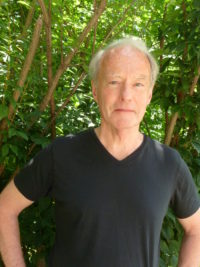How I long to make good from far
The forgotten gesture, the additional act.
Who, among us, has not heard such words whispering into our silences?
Then I stopped by a swampy area at the end of the lake and took a look through the gently swaying bushes. A blue heron stood stock still on the far side, as if it were a statue or a silhouetted profile on an ancient Greek vase. I froze and watched intently, lost in the sight of the bird's eerie stillness. For an instant I was that blue heron. Its immobility and my stop-time staring seemed to fuse us in the way one is transported into a cataleptic state when watching dust motes in a flash of sunlight or unexpectedly seeing the full moon hanging on the world's edge when stepping outdoors with night coming on. It seems at these moments that a crack opens in the conventional reality machine that runs the world and one shivers with an erotic happiness that transcends description. Berger calls these "enclaves of the beyond."
When I finally shook myself loose from being the heron, I walked on by myself but with many voices whispering in my ears. Kris Kristofferson, whom I had recently seen in a documentary on country music, was singing "Me and Bobby McGee," which took me back to a night years ago when a woman I knew played the song over and over for me as she drank wine in her low-cut dress, coming on to me, even as my then wife sat with us.
There is an infinite sadness in this memory, the loneliness of her yearning, not just for sex but for love, for a relationship, for tenderness, for "that which is held," and while I remember the night vividly, I sadly can't remember her name and she slips into the penumbra of the dreamy past. But vividly alive, present. She walks with me as I head down the road, where the sign reads: Rough Road Ahead. The words live:
"Then somewhere near Salinas, Lord, I let her slip away/She was lookin' for the love I hope she'll find."
Just a moment of time out of mind. A moment the time-keepers can't imagine.
We know it. We live it. We use and are used by our memories and forgetteries in equal measure, thinking we control the flow of life, which we don't.
There is an experience that lovers, writers, singers, and athletes have. Everyone has it at least once in a lifetime, or so I hope. It is called by some "being in the zone," by others "being unconscious," by others "ecstasy" and "inspiration"; in all cases it transcends clocks and the underlying bias of our age. It is hope incarnate. It is time out of mind. By discounting it, we embrace hopelessness, nihilism.
Living in the age of abstractions, we tend to abandon the body, the earth, and the chance that we might redeem this sordid era. By remembering that hope lies in the shadows, in the unexpected places and faces that flash through our times even when we are induced to believe we are only dreaming, we have a chance. But only if we reject the belief that entropy is time's arrow. Therein lies the real danger that will result in our forgetting of how instantly time can stand still in the ultimate sense, as it did for the Japanese victims of America's murderous rage on August 6, 1945. Galway Kinnell, in his poem "The Fundamental Project of Technology" reminds us to remember:
The children go away. By nature they do. And by memory,
in scorched uniforms, holding tiny crushed lunch tins.
All the ecstasy-groans of each night call them back, satori
their ghostliness back into the ashes, in the momentary shrines,
the thankfulness of arms, from which they will go
again and again, until the day flashes and no one lives
to look back and say, a flash, a white flash sparkled.
Where was the lightning before it flashed? To us it wasn't. Its flashing was it. It was its act. But the nuclear weapons that we once used and are now preparing to use already exist and if they flash again all time will be extinguished and we will be gone with it.
The road ahead is rough indeed. A despairing teleology will not save us. We need to see it for the trap that it is.
Rhythm, melody, and movement: from these life is born and sustained. They are also integral to art music, writing, painting, sculpture, dance, etc. even when they are apparently absent, as with my distorted perception of the seemingly immobile heron. They lie at the heart of spiritual experience, as breath is the inspiration that carries us along.
As I walk up the hill past the lake and my respiration increases, I see Alberto Giacometti's sculpture, "Tall Walking Figure" in my mind's eye. Its immobility implies movement, just as the ticking of the turning clock down through the ages has implied the earth's solid resistance to time's final victory, as the seasons turn and renew themselves timelessly. Movement and stasis, time and the timeless. Such paradoxical inclusiveness pertains to still-life painting as well. While seemingly immobile, and defined by some as dead life encompassed by the presence of the absence of movement and change, the essence of all living things, such paintings come to life in the encounter with the living. Relationship is all. To grasp the paradoxical nature of art and life one must approach them as an artist and see the wholeness in broken pieces.
(Note: You can view every article as one long page if you sign up as an Advocate Member, or higher).





